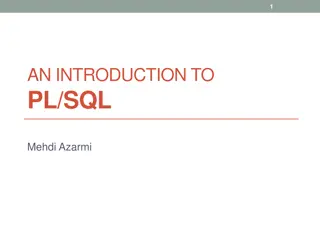Understanding SQL Views for Efficient Data Management
SQL Views are virtual tables in a database that provide a way to structure, restrict access, and summarize data for better management. Learn how to create, update, insert, and delete rows in views to enhance your data handling efficiency.
Download Presentation

Please find below an Image/Link to download the presentation.
The content on the website is provided AS IS for your information and personal use only. It may not be sold, licensed, or shared on other websites without obtaining consent from the author. Download presentation by click this link. If you encounter any issues during the download, it is possible that the publisher has removed the file from their server.
E N D
Presentation Transcript
Lesson 41 SQL VIEWS Trainer: Bach Ngoc Toan TEDU Website: http://tedu.com.vn
SQL VIEWS In SQL, a view is a virtual table based on the result-set of an SQL statement. A view contains rows and columns, just like a real table. The fields in a view are fields from one or more real tables in the database. You can add SQL functions, WHERE, and JOIN statements to a view and present the data as if the data were coming from one single table.
SQL - USING VIEWS Views, which are a type of virtual tables allow users to do the following Structure data in a way that users or classes of users find natural or intuitive. Restrict access to the data in such a way that a user can see and (sometimes) modify exactly what they need and no more. Summarize data from various tables which can be used to generate reports.
CREATE VIEW SYNTAX CREATE VIEW view_name AS SELECT column1, column2, ... FROM table_name WHERE condition; The WITH CHECK OPTION CREATE VIEW CUSTOMERS_VIEW AS SELECT name, age FROM CUSTOMERS WHERE age IS NOT NULL WITH CHECK OPTION;
UPDATING A VIEW A view can be updated under certain conditions which are given below The SELECT clause may not contain the keyword DISTINCT. The SELECT clause may not contain summary functions. The SELECT clause may not contain set functions. The SELECT clause may not contain set operators. The SELECT clause may not contain an ORDER BY clause. The FROM clause may not contain multiple tables. The WHERE clause may not contain subqueries. The query may not contain GROUP BY or HAVING. Calculated columns may not be updated. All NOT NULL columns from the base table must be included in the view in order for the INSERT query to function.
INSERTING ROWS INTO A VIEW Rows of data can be inserted into a view. The same rules that apply to the UPDATE command also apply to the INSERT command. Here, we cannot insert rows in the CUSTOMERS_VIEW because we have not included all the NOT NULL columns in this view, otherwise you can insert rows in a view in a similar way as you insert them in a table.
DELETING ROWS INTO A VIEW Rows of data can be deleted from a view. The same rules that apply to the UPDATE and INSERT commands apply to the DELETE command. Following is an example to delete a record having AGE = 22. SQL > DELETE FROM CUSTOMERS_VIEW WHERE age = 22;
SQL UPDATING A VIEW CREATE OR REPLACE VIEW view_name AS SELECT column1, column2, ... FROM table_name WHERE condition;
SQL DROPPING A VIEW DROP VIEW view_name;























